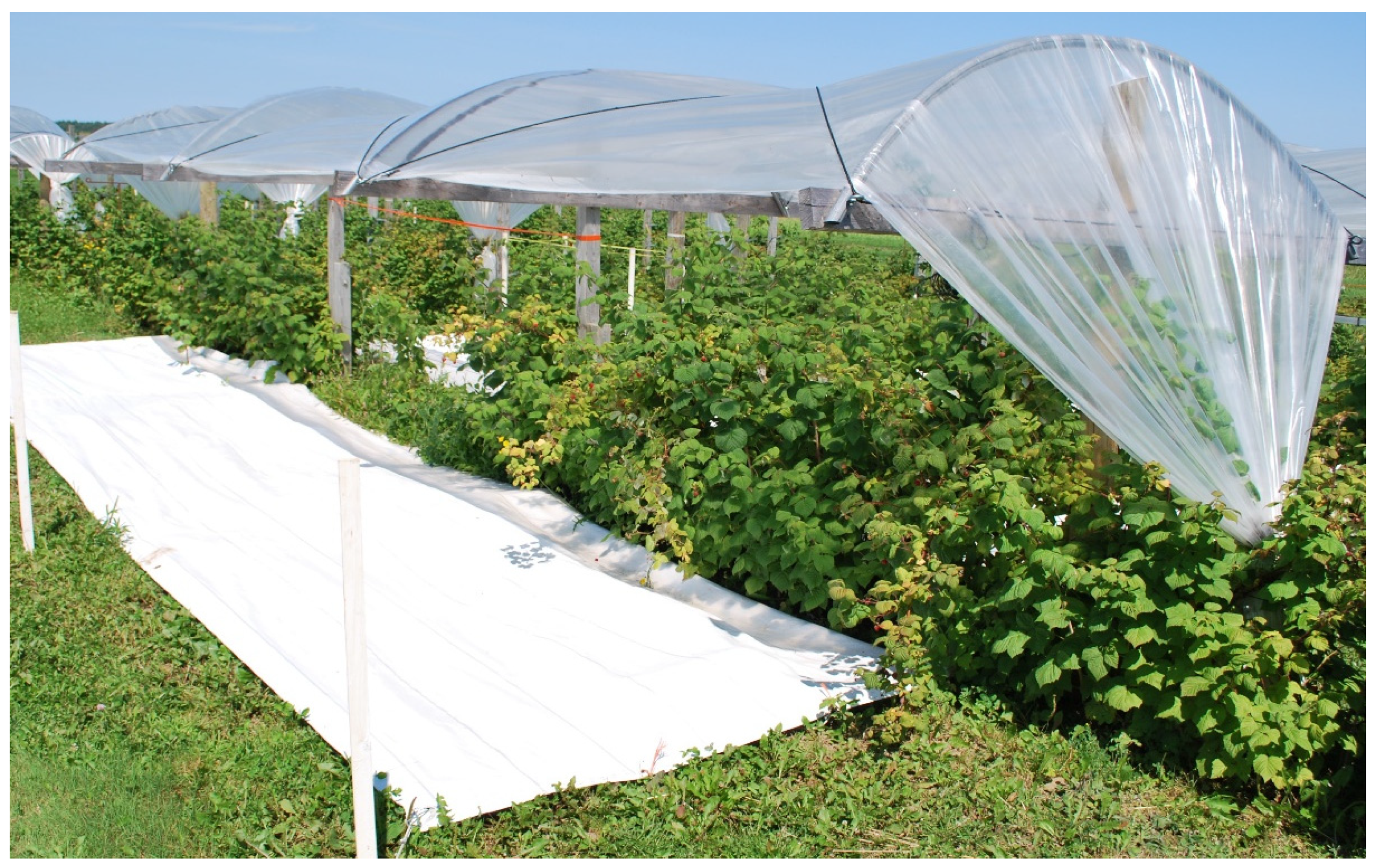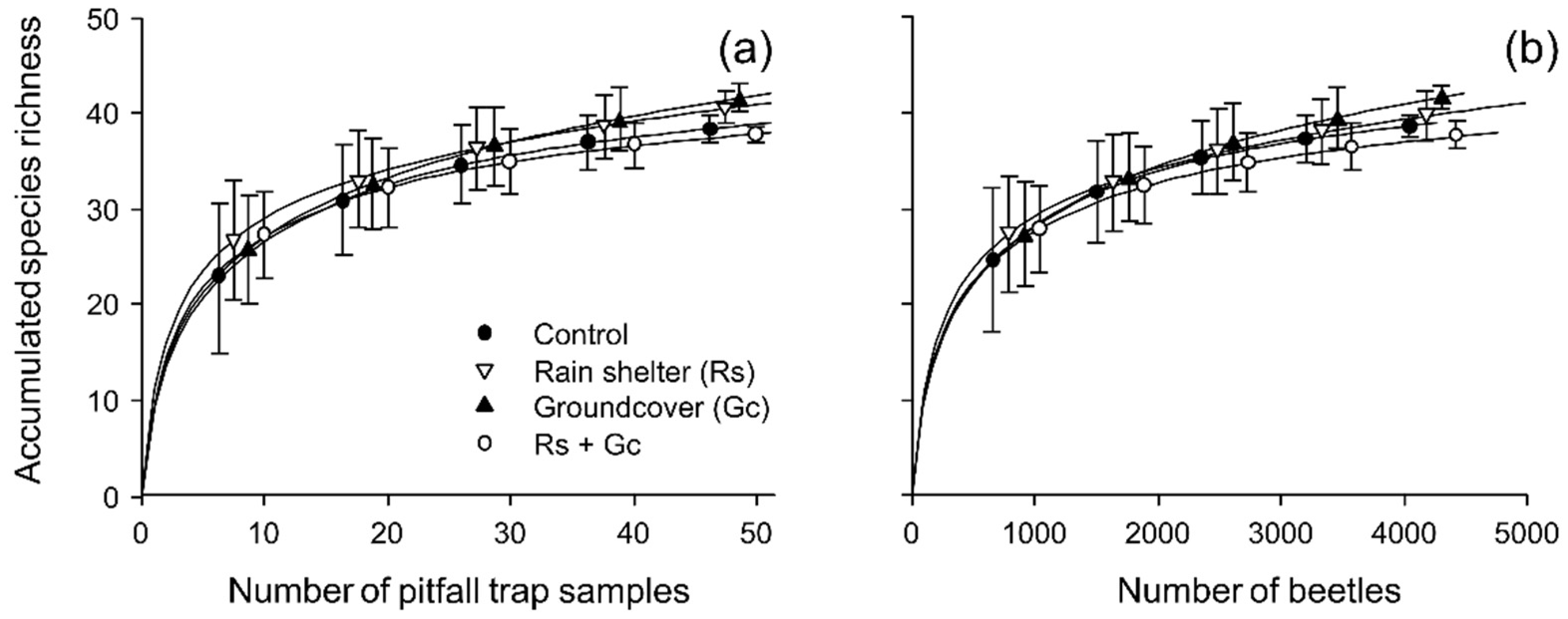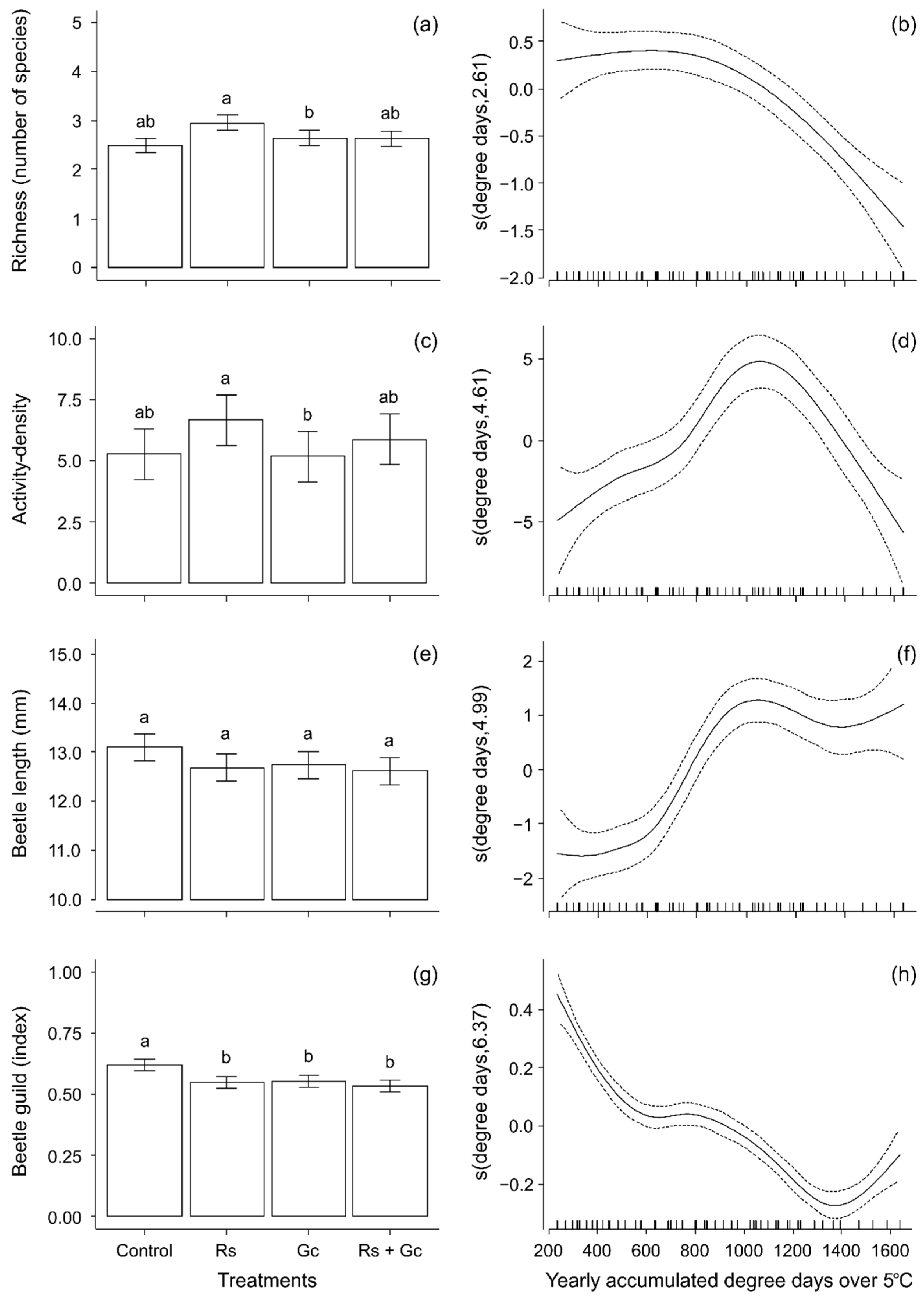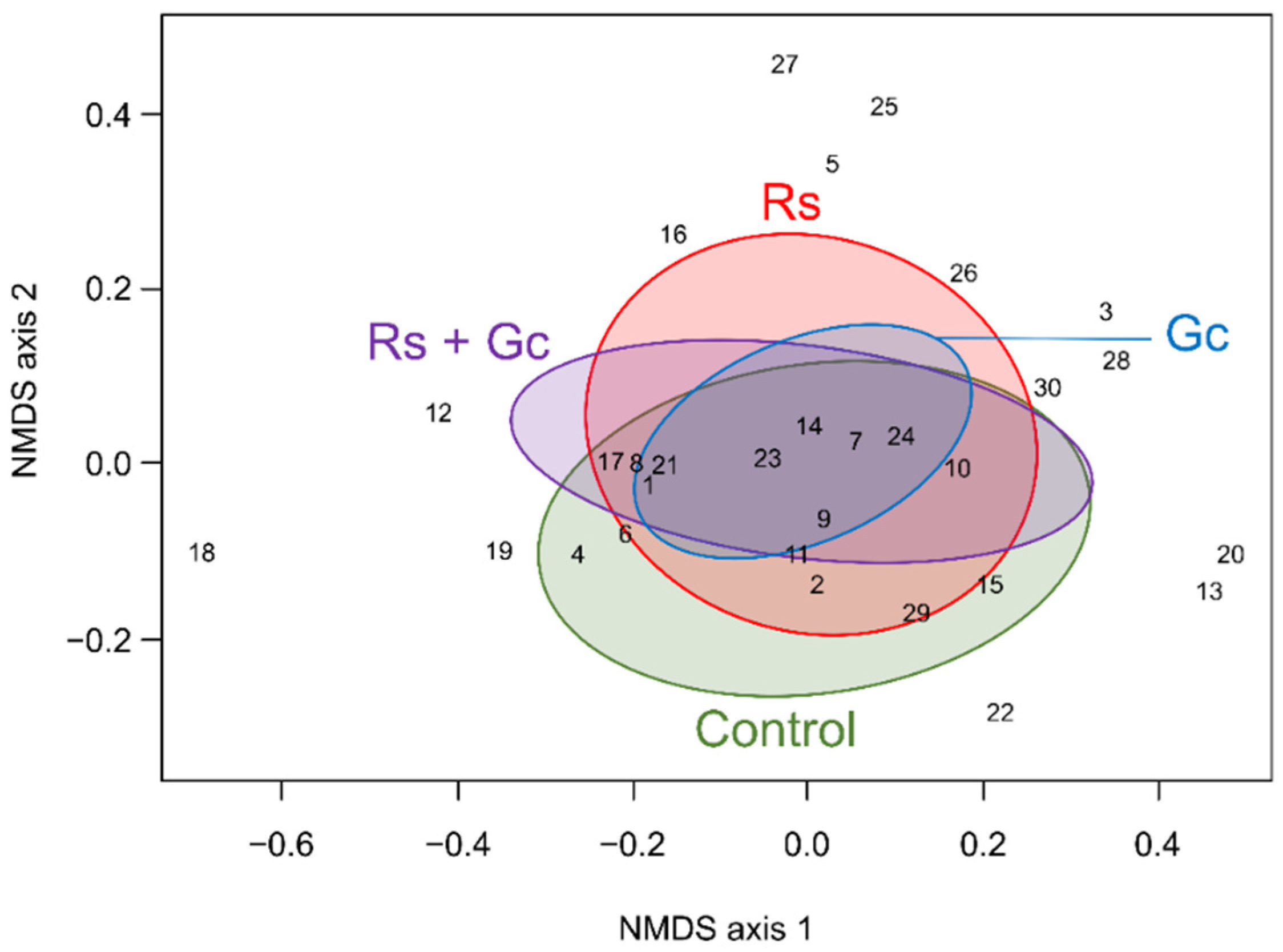Groundcovers and Rain Shelters Alter Co-Occurrence Patterns among Ground Beetle Communities in an Organic Raspberry Crop
Abstract
:Simple Summary
Abstract
1. Introduction
2. Materials and Methods
2.1. Study Sites
2.2. Treatments
2.3. Ground Beetle Sampling and Identification
2.4. Statistical Analyses
3. Results
3.1. Effects of Treatments on Ground Beetles
3.2. Effects of Treatments on Ground Beetle Occurrence, Co-Occurrence and Interactions
4. Discussion
5. Conclusions
Supplementary Materials
Author Contributions
Funding
Institutional Review Board Statement
Informed Consent Statement
Data Availability Statement
Acknowledgments
Conflicts of Interest
References
- Xiao, C.L.; Chandler, C.K.; Price, J.F.; Duval, J.R.; Mertely, J.C.; Legard, D.E. Comparison of epidemics of Botrytis fruit rot and powdery mildew of strawberry in large plastic tunnel and field production systems. Plant Dis. 2001, 85, 901–909. [Google Scholar] [CrossRef]
- Comeau, C.; Privé, J.-P.; Moreau, G. Beneficial impacts of the combined use of rain shelters and reflective groundcovers in an organic raspberry cropping system. Agr. Ecosyst. Environ. 2012, 155, 117–123. [Google Scholar] [CrossRef]
- Rohloff, J.; Nestby, R.; Folkestad, J.A.; Iversen, T.-H. Influence of rain cover cultivation on taste and aroma quality of strawberries (Fragaria ananassa Duch.). J. Food Agric. Environ. 2004, 2, 74–82. [Google Scholar]
- Privé, J.P.; Russell, L.; Leblanc, A. Use of Extenday reflective groundcover in production of ‘Gala’ apples (Malus domestica) in New Brunswick, Canada: 1. Impact on canopy microclimate and leaf gas exchange. N. Z. J. Crop Hortic. Sci. 2008, 36, 221–231. [Google Scholar] [CrossRef] [Green Version]
- Bazzaz, F.A. Plant species diversity in old-field successional ecosystems in Southern Illinois. Ecology 1975, 56, 483–485. [Google Scholar] [CrossRef]
- Rosenzweig, M.L. Species Diversity in Space and Time; Cambridge University Press: Cambridge, UK, 1995. [Google Scholar]
- McCann, K.S. The diversity–stability debate. Nature 2000, 405, 228–233. [Google Scholar] [CrossRef]
- MacArthur, R.H.; Wilson, E.O. The Theory of Island Biogeography; Princeton University Press: Princeton, NJ, USA, 1967. [Google Scholar]
- Ralph, C.J. Habitat association patterns of forest and steppe birds of northern Patagonia, Argentina. Condor 1985, 87, 471–483. [Google Scholar] [CrossRef]
- Sullivan, T.P.; Sullivan, D.S. Influence of variable retention harvests on forest ecosystems. II. Diversity and population dynamics of small mammals. J. Appl. Ecol. 2001, 38, 1234–1252. [Google Scholar] [CrossRef]
- Reynolds, H.L.; Mittelbach, G.G.; Darcy-Hall, T.L.; Houseman, G.R.; Gross, K.L. No effect of varying soil resource heterogeneity on plant species richness in a low fertility grassland. J. Ecol. 2007, 95, 723–733. [Google Scholar] [CrossRef]
- Tews, J.; Brose, U.; Grimm, V.; Tielbörger, K.; Wichmann, M.C.; Schwager, M.; Jeltsch, F. Animal species diversity driven by habitat heterogeneity/diversity: The importance of keystone structures. J. Biogeogr. 2004, 31, 79–92. [Google Scholar] [CrossRef] [Green Version]
- MacArthur, R.H.; MacArthur, J.W. On bird species diversity. Ecology 1961, 42, 594–598. [Google Scholar] [CrossRef]
- Huffaker, C. Experimental studies on predation: Dispersion factors and predator-prey oscillations. Hilgardia 1958, 27, 343–383. [Google Scholar] [CrossRef] [Green Version]
- Moreau, G.; Eveleigh, E.S.; Lucarotti, C.J.; Quiring, D.T. Ecosystem alteration modifies the relative strengths of bottom-up and top-down forces in a herbivore population. J. Anim. Ecol. 2006, 75, 853–861. [Google Scholar] [CrossRef] [PubMed] [Green Version]
- Moreau, G.; Eveleigh, E.S.; Lucarotti, C.J.; Quiring, D.T. Stage- specific responses to ecosystem alteration in an eruptive herbivorous insect. J. Appl. Ecol. 2006, 43, 28–34. [Google Scholar] [CrossRef]
- Mourant, A.; Lecomte, N.; Moreau, G. Indirect effects of an ecosystem engineer: How the Canadian beaver can drive the reproduction of saproxylic beetles. J. Zool. 2018, 304, 90–97. [Google Scholar] [CrossRef]
- Pimentel, D. Species diversity and insect population outbreaks. Ann. Entomol. Soc. Am. 1961, 54, 76–86. [Google Scholar] [CrossRef]
- Siemann, E.; Tilman, D.; Haarstad, J.; Ritchie, M. Experimental tests of the dependence of arthropod diversity on plant diversity. Am. Nat. 1998, 152, 738–750. [Google Scholar] [CrossRef]
- Goguen, J.; Moreau, G. Exogenous and endogenous factors acting on the spatial distribution of a chrysomelid in extensively managed blueberry fields. Agr. For. Entomol. 2015, 17, 181–187. [Google Scholar] [CrossRef]
- Larochelle, A.; Larivière, M.-C. Natural History of the Ground-Beetles (Coleoptera: Carabidae) of America North of Mexico; Pensoft Publishers: Sofia, Bulgaria, 2003. [Google Scholar]
- Holland, J.M.; Thomas, C.F.G.; Birkett, T.; Southway, S. Spatio-temporal distribution and emergence of beetles in arable fields in relation to soil moisture. Bull. Entomol. Res. 2007, 97, 89–100. [Google Scholar] [CrossRef]
- Ings, T.C.; Hartley, S.E. The effect of habitat structure on carabid communities during the regeneration of a native Scottish forest. For. Ecol. Manag. 1999, 119, 123–136. [Google Scholar] [CrossRef]
- Rainio, J.; Niemelä, J. Ground beetles (Coleoptera: Carabidae) as bioindicators. Biodivers. Conserv. 2003, 12, 487–506. [Google Scholar] [CrossRef]
- Borchard, F.; Buchholz, S.; Helbing, F.; Fartmann, T. Carabid beetles and spiders as bioindicators for the evaluation of montane heathland restoration on former spruce forests. Biol. Conserv. 2014, 178, 185–192. [Google Scholar] [CrossRef]
- Holland, J.M.; Thomas, C.F.G.; Birkett, T.; Southway, S.; Oaten, H. Farm-scale spatiotemporal dynamics of predatory beetles in arable crops. J. Appl. Ecol. 2005, 42, 1140–1152. [Google Scholar] [CrossRef]
- Diamond, J.M. Assembly of species communities. In Ecology and Evolution of Communities; Cody, M.L., Diamond, J.M., Eds.; Harvard University Press: Cambridge, UK, 1975; pp. 342–444. [Google Scholar]
- Comeau, C.; Privé, J.-P.; Moreau, G. Effects of reflective groundcovers on ground beetles (Coleoptera: Carabidae) in red raspberry (Rubus idaeus) cropping systems. J. Appl. Entomol. 2013, 137, 264–274. [Google Scholar] [CrossRef]
- Bousquet, Y. Illustrated Identification Guide to Adults and Larvae of Northeastern North American Ground Beetles (Coleoptera: Carabidae); Pensoft Publishers: Sofia, Bulgaria, 2010. [Google Scholar]
- R Core Team. R: A Language and Environment for Statistical Computing; R Foundation for Statistical Computing: Vienna, Austria, 2018. [Google Scholar]
- Tretzel, E. Technik und Bedeutung des Fallenfanges für ökologische Untersuchungen. Zool. Anz. 1955, 155, 276–287. [Google Scholar]
- Gotelli, N.J.; Entsminger, G.L. EcoSim: Null Models Software for Ecology. Version 7.0; Acquired Intelligence Inc. & Kesey-Bear: Burlington, VT, USA, 2001. [Google Scholar]
- Stone, L.; Roberts, A. The checkerboard score and species distributions. Oecologia 1990, 85, 74–79. [Google Scholar] [CrossRef]
- Hochberg, Y.; Benjamini, Y. More powerful procedures for multiple significance testing. Statist. Med. 1990, 9, 811–818. [Google Scholar] [CrossRef]
- Griffith, D.M.; Veech, J.A.; Marsh, C.J. Cooccur: Probabilistic species co-occurrence analysis in R. J. Stat. Softw. 2016, 69, 1–17. [Google Scholar] [CrossRef]
- Campbell, J.M.; Sarazin, M.J.; Lyons, D.B. Canadian Beetles (Coleoptera) Injurious to Crops, Ornamentals, Stored Products, and Buildings; Agriculture Canada: Ottawa, ON, Canada, 1989. [Google Scholar]
- Holland, J.M. Carabid beetles: Their ecology, survival and use in agroecosystems. In The Agroecology of Carabid Beetles; Holland, J.M., Ed.; Intercept Limited: Andover, UK, 2002; Volume 62, ISBN 1898298769. [Google Scholar]
- Farnon Ellwood, M.D.; Manica, A.; Foster, W.A. Stochastic and deterministic processes jointly structure tropical arthropod communities. Ecol. Lett. 2009, 12, 277–284. [Google Scholar] [CrossRef]
- Lövei, G.L.; Sunderland, K.D. Ecology and behaviour of ground beetles (Coleoptera: Carabidae). Annu. Rev. Entomol. 1996, 41, 231–256. [Google Scholar] [CrossRef]
- Kromp, B. Carabid beetles in sustainable agriculture: A review on pest control efficacy, cultivation impacts and enhancement. Agr. Ecosyst. Environ. 1999, 74, 187–228. [Google Scholar] [CrossRef]
- Masters, G.J.; Brown, V.K.; Clarke, I.P.; Whittaker, J.B.; Hollier, J.A. Direct and indirect effects of climate change on insect herbivores: Auchenorrhyncha (Homoptera). Ecol. Entomol. 1998, 23, 45–52. [Google Scholar] [CrossRef]
- Kratky, B.A. Plastic-covered Rainshelters for Vegetable Production in The Tropics. In Proceedings of the 33th National Agricultural Plastics Congress of the American Society for Plasticulture, Belafonte, PA, USA, 2–5 November 2006. [Google Scholar]
- Lim, K.H.; Gu, M.; Song, J.H.; Cho, Y.S.; Kim, W.S.; Kim, B.S.; Jung, S.K.; Choi, H.S. Growth, fruit production, and disease occurrence of rain-sheltered Asian pear trees. Sci. Hortic. 2014, 177, 37–42. [Google Scholar] [CrossRef]
- Pimentel, D.; Hepperly, P.; Hanson, J.; Douds, D.; Seidel, R. Environmental, energetic, and economic comparisons of organic and conventional farming systems. Bioscience 2005, 55, 573–582. [Google Scholar] [CrossRef]
- Tscharntke, T.; Klein, A.M.; Kruess, A.; Steffan-Dewenter, I.; Thies, C. Landscape perspectives on agricultural intensification and biodiversity–ecosystem service management. Ecol. Lett. 2005, 8, 857–874. [Google Scholar] [CrossRef]
- Holzschuh, A.; Steffan-Dewenter, I.; Tscharntke, T. Agricultural landscapes with organic crops support higher pollinator diversity. Oikos 2008, 117, 354–361. [Google Scholar] [CrossRef]
- Privé, J.-P.; Russell, L.; LeBlanc, A. Impact of reflective groundcover on growth, flowering, yield and fruit quality in Gala apples in New Brunswick. Can. J. Plant Sci. 2011, 91, 765–772. [Google Scholar] [CrossRef]





| Species | Control | Ground-Cover (Gc) | Rain Shelter (Rs) | Rs + Gc | Total | Feeding Guild | Body Length (mm) |
|---|---|---|---|---|---|---|---|
| Harpalus rufipes (DeGeer) | 2014 | 2369 | 2492 | 2622 | 9497 | H | 13.4 |
| Pterostichus melanarius (Illiger) | 761 | 588 | 500 | 573 | 2422 | C | 15.5 |
| Amara familiaris (Duftschmid) | 385 | 400 | 529 | 436 | 1750 | O | 6.4 |
| Agonum muelleri (Herbst) | 281 | 233 | 260 | 228 | 1002 | C | 8.4 |
| Amara fulva (O.F. Müller) | 69 | 150 | 145 | 112 | 476 | H | 9.2 |
| Carabus granulatus Linnaeus | 107 | 117 | 129 | 98 | 451 | O | 20.0 |
| Bembidion properans (Stephens) | 89 | 87 | 173 | 72 | 421 | C | 3.9 |
| Harpalus affinis (Schrank) | 73 | 72 | 134 | 134 | 413 | O | 10.3 |
| Carabus nemoralis O.F. Müller | 109 | 99 | 78 | 76 | 362 | C | 23.5 |
| Amara aenea (DeGeer) | 112 | 67 | 94 | 81 | 354 | O | 7.5 |
| Poecilus lucublandus (Say) | 47 | 50 | 48 | 33 | 178 | O | 11.5 |
| Amara bifrons (Gyllenhal) | 10 | 15 | 71 | 46 | 142 | H | 6.2 |
| Harpalus rubripes (Duftschmid) | 30 | 20 | 56 | 35 | 141 | - | 10.4 |
| Bembidion quadrimaculatum oppositum Say | 22 | 40 | 37 | 27 | 126 | C | 3.3 |
| Harpalus somnulentus Dejean | 26 | 28 | 28 | 40 | 122 | C | 9.9 |
| Agonum placidum (Say) | 14 | 10 | 25 | 7 | 56 | O | 7.8 |
| Loricera pilicornis (Fabricius) | 7 | 16 | 13 | 15 | 51 | C | 7.3 |
| Stenolophus comma (Fabricius) | 4 | 35 | 2 | 6 | 47 | O | 6.6 |
| Agonum cupripenne (Say) | 15 | 8 | 10 | 13 | 46 | C | 8.4 |
| Amara cupreolata Putzeys | 9 | 9 | 19 | 7 | 44 | O | 7.3 |
| Amara neoscotica Casey | 11 | 8 | 11 | 14 | 44 | - | 7.9 |
| Amara aulica (Panzer) | 7 | 6 | 21 | 8 | 42 | H | 12.7 |
| Harpalus herbivagus Say | 7 | 9 | 16 | 5 | 37 | O | 8.5 |
| Clivina fossor (Linnaeus) | 5 | 4 | 9 | 18 | 36 | O | 6.0 |
| Amara latior (Kirby) | 9 | 1 | 18 | 4 | 32 | C | 9.9 |
| Amara apricaria (Paykull) | 3 | 8 | 13 | 5 | 29 | O | 7.8 |
| Amara avida (Say) | 4 | 5 | 8 | 3 | 20 | O | 8.6 |
| Amara otiosa Casey | 2 | 4 | 7 | 1 | 14 | - | 7.8 |
| Anisodactylus nigrita Dejean | 5 | 4 | 2 | 3 | 14 | C | 11.8 |
| Elaphropus incurvus (Say) | 2 | 2 | 4 | 4 | 12 | C | 2.3 |
| Amara littoralis Dejean | 0 | 2 | 3 | 4 | 9 | O | 8.0 |
| Carabus serratus Say | 0 | 1 | 2 | 5 | 8 | O | 20.0 |
| Harpalus pensylvanicus (DeGeer) | 0 | 1 | 5 | 0 | 6 | O | 12.7 |
| Amara patruelis Dejean | 3 | 0 | 1 | 0 | 4 | C | 8.7 |
| Blemus discus (Fabricius) | 1 | 1 | 1 | 1 | 4 | C | 5.0 |
| Chlaenius sericeus (Forster) | 3 | 0 | 1 | 0 | 4 | C | 13.8 |
| Pterostichus mutus (Say) | 2 | 2 | 0 | 0 | 4 | C | 11.5 |
| Agonum octopunctatum (Fabricius) | 1 | 0 | 0 | 2 | 3 | C | 8.0 |
| Anisodactylus sanctaecrucis (Fabricius) | 1 | 2 | 0 | 0 | 3 | O | 9.6 |
| Stomis pumicatus (Panzer) | 1 | 1 | 0 | 1 | 3 | - | 7.5 |
| Dyschiriodes globulosus (Say) | 0 | 1 | 1 | 0 | 2 | C | 2.9 |
| Omophron americanum Dejean | 0 | 2 | 0 | 0 | 2 | C | 6.1 |
| Synuchus impunctatus (Say) | 0 | 1 | 1 | 0 | 2 | O | 9.4 |
| Amara pallipes Kirby | 0 | 1 | 0 | 0 | 1 | H | 7.1 |
| Amara quenseli (Schönherr) | 0 | 0 | 0 | 1 | 1 | O | 6.8 |
| Anisodactylus rusticus (Say) | 1 | 0 | 0 | 0 | 1 | O | 10.0 |
| Apristus subsulcatus (Dejean) | 0 | 0 | 1 | 0 | 1 | - | 3.8 |
| Bembidion versicolor (LeConte) | 0 | 1 | 0 | 0 | 1 | C | 3.2 |
| Chlaenius emarginatus Say | 0 | 0 | 0 | 1 | 1 | O | 13.6 |
| Notiophilus aquaticus (Linnaeus) | 0 | 0 | 1 | 0 | 1 | C | 5.3 |
| Oxypselaphus pusillus (LeConte) | 1 | 0 | 0 | 0 | 1 | C | 6.1 |
| Pterostichus adstrictus Eschscholtz | 0 | 0 | 0 | 1 | 1 | C | 11.3 |
| Stenolophus conjuctus (Say) | 0 | 0 | 1 | 0 | 1 | C | 3.8 |
| Stenolophus thoracicus Casey | 0 | 0 | 1 | 0 | 1 | - | 3.8 |
| Block | Year | Degree Days | Treatments | |
|---|---|---|---|---|
| Richness | 64.64 ** | 6.30 * | 24.17 ** | 5.97 ** |
| Activity-density | 36.23 ** | 49.96 ** | 15.87 ** | 2.67 * |
| Beetle length | 39.17 ** | 0.07 | 30.09 ** | 2.14 |
| Beetle function | 30.49 ** | 84.83 ** | 74.56 ** | 8.72 ** |
Publisher’s Note: MDPI stays neutral with regard to jurisdictional claims in published maps and institutional affiliations. |
© 2022 by the authors. Licensee MDPI, Basel, Switzerland. This article is an open access article distributed under the terms and conditions of the Creative Commons Attribution (CC BY) license (https://creativecommons.org/licenses/by/4.0/).
Share and Cite
Moreau, G.; Comeau, C.; Privé, J.-P. Groundcovers and Rain Shelters Alter Co-Occurrence Patterns among Ground Beetle Communities in an Organic Raspberry Crop. Insects 2022, 13, 413. https://doi.org/10.3390/insects13050413
Moreau G, Comeau C, Privé J-P. Groundcovers and Rain Shelters Alter Co-Occurrence Patterns among Ground Beetle Communities in an Organic Raspberry Crop. Insects. 2022; 13(5):413. https://doi.org/10.3390/insects13050413
Chicago/Turabian StyleMoreau, Gaétan, Charles Comeau, and Jean-Pierre Privé. 2022. "Groundcovers and Rain Shelters Alter Co-Occurrence Patterns among Ground Beetle Communities in an Organic Raspberry Crop" Insects 13, no. 5: 413. https://doi.org/10.3390/insects13050413
APA StyleMoreau, G., Comeau, C., & Privé, J. -P. (2022). Groundcovers and Rain Shelters Alter Co-Occurrence Patterns among Ground Beetle Communities in an Organic Raspberry Crop. Insects, 13(5), 413. https://doi.org/10.3390/insects13050413






